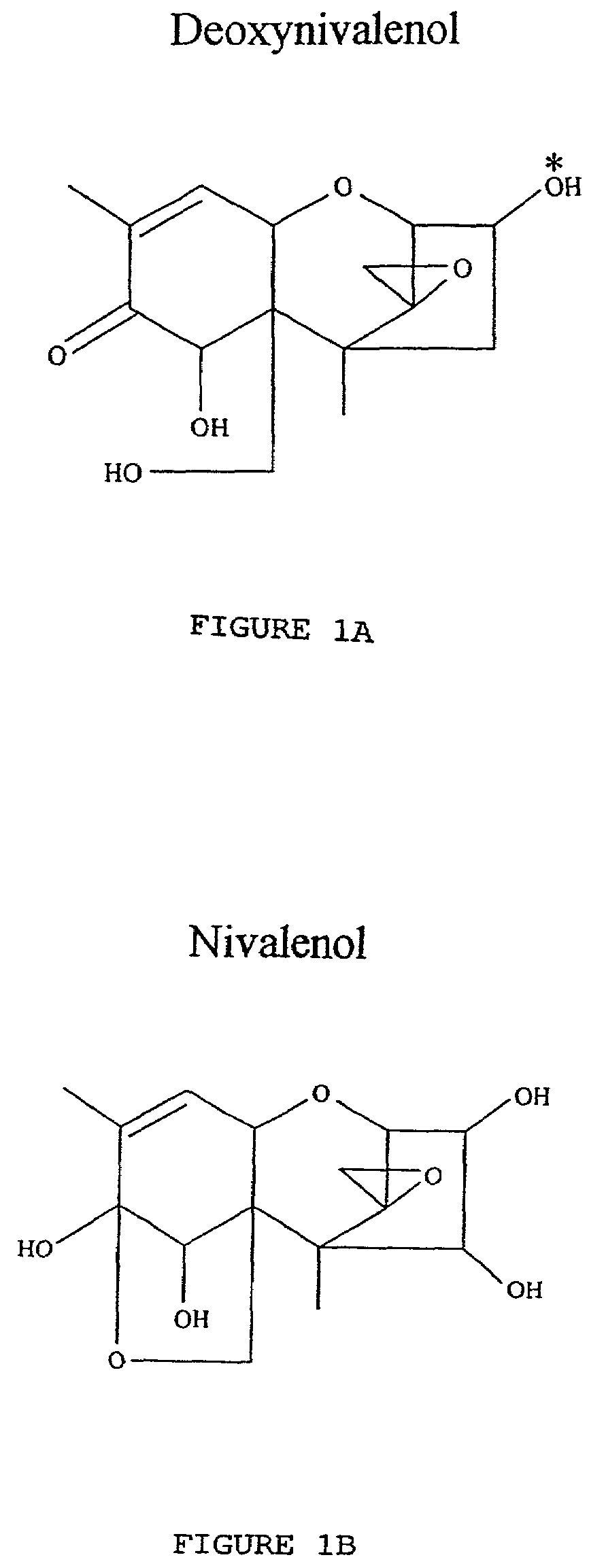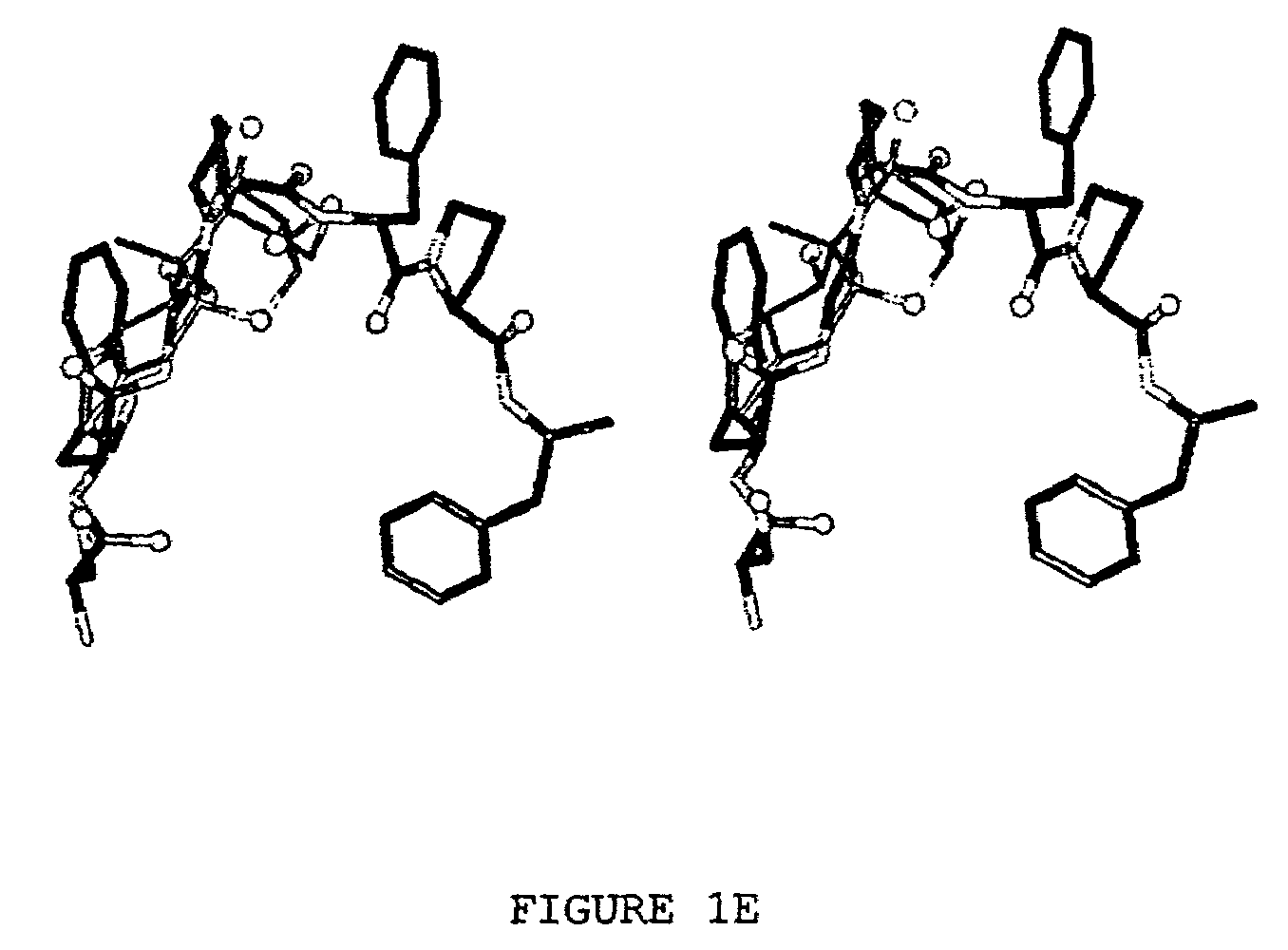Plant cells encoding a peptide mimotope to mycotoxin deoxynivalenol and uses thereof
- Summary
- Abstract
- Description
- Claims
- Application Information
AI Technical Summary
Benefits of technology
Problems solved by technology
Method used
Image
Examples
example 1
[0073]Identification of peptide mimotopes which bind to mycotoxin DON-specific monoclonal antibody. Monoclonal antibody 6F5 (mAB 6F5) was used to select for peptides that mimic the mycotoxin from a library of filamentous phages that have random 7-mer peptides on their surfaces.
[0074]A phage-display heptapeptide library containing 2×109 independent clones that express random peptide 7-mers fused to minor coat protein g3p of filamentous coliphage M13 was purchased from New England Biolabs, Inc. Beverly, Mass. The library had sufficient complexity to contain most if not all of the 207=1.28×910 possible 7-mer sequences. After amplification in Escherichia coli ER2537 (purchased from New England Biolabs, Inc.), the phage in the library were selected by panning elution as below.
[0075]One hundred microliters of a preparation containing mAB 6F5 (prepared as shown in Casale et al., Op. cit.) at 15 μg / ml in 0.01 M phosphate-buffered saline (PBS) (pH 7.4) was dispensed into each well of disposa...
example 2
[0079]This example demonstrates that DON mimotope peptides actually mimicked the epitope recognized by mAB 6F5 and was not nonspecifically bound to the surface of the antibody molecule outside the antigen binding site. Competitive ELISAs were used to show that both phage isolates encoding either peptide competed with DON for the antigen binding site.
[0080]To perform a competitive direct ELISA (CD-ELISA) with the phage-displayed peptide, INMUNO-4 microtiter wells were coated with mAB 6F5 and blocked as described in Example 1. Various concentrations of DON (0 to 10,000 ηg / ml in 1% methanol-PBS) were mixed with equal volumes of phage-displayed peptide (diluted 1:10 in 10% milk-PBS). The mixtures were added to mAB 6F5-coated microtiter wells (100 μl / well), and the preparations were incubated at 37° C. for 1 hour. Afterwards, the wells were washed 6 times with PBS-T (about 300 μl / well) and then amounts of bound recombinant phage were determined by incubating the preparations with 100 μl ...
example 3
[0083]This example demonstrates that a synthetic peptide, C430, which comprises the amino acid sequence SWGPFP (SEQ ID NO:2), was alone was sufficient for binding to the mAB, independent of the phage structural context.
[0084]C430, a DON peptide mimotope with a structurally flexible linker and a cysteine residue, which has the sequence NH2-SWGPFPFGGGSC-COOH (SEQ ID NO:5) was synthesized via N-(9-fluorenylmethoxycarbonyl) (Fmoc) chemistry at Bio-Synthesis, Inc. of Lewisville, Tex. C430 was used at various concentrations to compete with DON-HRP for binding to mAB 6F5 in a CD-ELISA. C430 was also conjugated to HRP with a sulfo-MBS cross-linker. The procedure used for the CD-ELISA performed with the C430-HRP conjugate was the same as the procedure used for the ELISA performed with DON-HRP described above, except that C430-HRP (diluted 1:5,000 in blocking buffer) replaced the DON-HRP.
[0085]The results shown in FIG. 3A show that binding of DON-HRP to immobilized mAB 6F5 was inhibited by fr...
PUM
| Property | Measurement | Unit |
|---|---|---|
| Electrical resistance | aaaaa | aaaaa |
| Inhibition | aaaaa | aaaaa |
Abstract
Description
Claims
Application Information
 Login to View More
Login to View More - R&D
- Intellectual Property
- Life Sciences
- Materials
- Tech Scout
- Unparalleled Data Quality
- Higher Quality Content
- 60% Fewer Hallucinations
Browse by: Latest US Patents, China's latest patents, Technical Efficacy Thesaurus, Application Domain, Technology Topic, Popular Technical Reports.
© 2025 PatSnap. All rights reserved.Legal|Privacy policy|Modern Slavery Act Transparency Statement|Sitemap|About US| Contact US: help@patsnap.com



